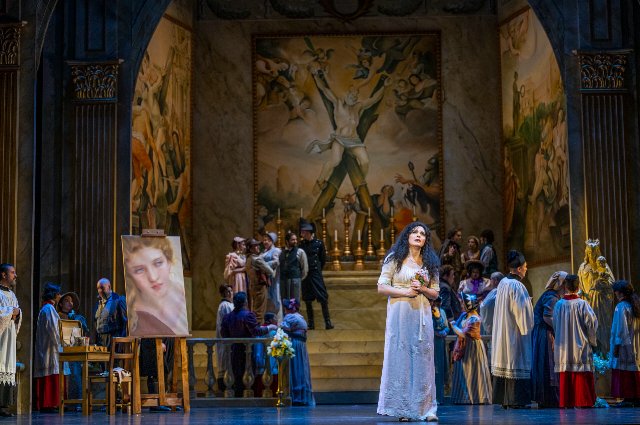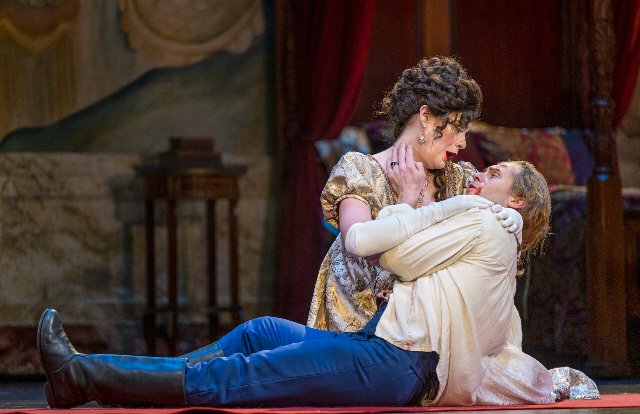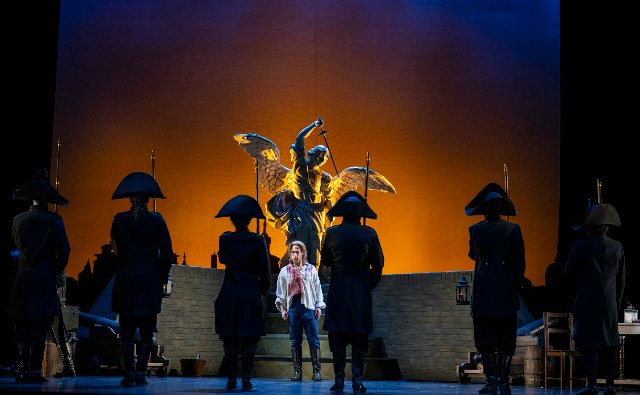Tosca
Love, Intrigue, Betrayal, Death. It's Opera.
By: Victor Cordell - Apr 17, 2023
Giacomo Puccini’s “Tosca” seems to be the most produced opera in the Bay Area these days, with at least four versions playing within six months in 2023. It has been one of the most performed operas in the world for over a century. There is a good reason for that. Beautiful music delights from curtain rise to fall, starting with the resounding orchestral chords of the Scarpia theme, and punctuated by memorable arias and powerful ensembles. Opera San José offers a beautifully staged and performed rendering that sears with passion.
The verismo-styled drama about real people is intense, and the stakes could not be higher. It is no secret to opera lovers that the four critical characters in the action will die separately and violently. To readers less familiar with the genre, let it be said that there are no spoilers in opera.
Puccini’s fascination with women and with their singing voices is evident in his oeuvre. Of his eight full length operas, the title character is female in six. The title is sometimes symbolic or metaphorical, as in “Madame Butterfly,” “La Rondine,” or “Girl of the Golden West.” In the case of “Tosca,” it is not only bold and direct, but she displays an unusually broad array of thoughts, motives, and behaviors. Has Puccini endowed any other heroine with the full range of emotions and the corresponding singing styles, which run the gamut from tender lyricism to scorching drama?
Into the role of Floria Tosca steps Maria Natale, and her time has come. Although young by opera standards, she demonstrates that she can do it all. From her entrance into the San Andrea della Valle church and her duet with her Mario Cavaradossi, who is painting a Madonna portrait for the church, Natale reveals a sweet and mellifluous lyricism, which aligns with her perky mien. Concerned that her lover may have another relationship on the side, even her pixyish jealousy is represented by lighthearted entreaties and coy little smiles.
It is hard to believe that in the following act, she will become a hardened, brazen murderer. But Chief of Police Baron Scarpia has had Cavaradossi imprisoned and tortured. Scarpia’s price for granting his release is that he has his way with Tosca, so when she sees the opportunity to stab the villain to death, she avails herself. In her Act 2 duets with the male principals as well as in their trio, Natale’s high wire singing shows the opposite end of her versatile voice. At high range and full volume, with the piercing voice of the kind expected of a Wagnerian soprano, she is nonetheless smooth and listenable. Very impressive.
Puccini wrote only one memorable aria for Tosca, but “Vissi d’arte” is one of the touchstones of any soprano’s canon. Natale delivers it with exquisite skill. However, the artistic decision was made to sing with full emotion from the first note. Stylistically, it benefits from starting as a plaintive lament with a crescendo to full throttle.
Cavaradossi is portrayed by Adrian Kramer, and his voice suits the role well. Hardly has the music begun when he renders the lovely “Recondita armonia.” Some opera afficionados, particularly those who lean toward the German repertory, may find his Italianate manner that corresponds to a country twang in American music, a bit emotive, but it is highly expressive and melodious. The tenor’s other highlight, handled with great conviction, comes as he faces execution. “E lucevan le stelle” exudes sorrow with the interplay of the condemned man’s voice and the mournful clarinet.
Kidon Choi portrays Scarpia, a cruel and vindictive official on the opposite side of the political divide from the other principal figures. At the start, Choi’s baritone voice seems a little choppy, and he doesn’t display the lecherousness of Scarpia as broadly as he could. But by the time he sings his signature piece, the powerful “Te Deum (Va, Tosca)” at the end of Act 1, his voice is in full flower and remains so until his death. A final singer to recognize is bass, Robert Balonek, who plays Angelotti, a friend of Cavaradossi and an escapee from political incarceration. Though the part is small, this character has profound impact on the proceedings, as his breakout and hiding in the church triggers the downfall of all of the principals. Balonek sings the role with unfailing power and accuracy.
Some of Director Tara Branham’s artistic decisions in this “Tosca” that fall outside the constraints of the libretto are unconventional. Cavaradossi is shown actually having a tryst, presumably with the model for his Madonna painting. Scarpia’s office includes a bed, which will play a role in the action. Also, some of the singing is done in a stand-and-deliver concert version style, from the front apron and facing the audience rather than characters facing one another. This benefits sound projection but at the price of dramatic realism. Nonetheless, the production excels. The singing sizzles; the action compels; and the staging impresses. Steven C. Kemp’s scenery depicting the church includes beautiful arched colonnades and expansive murals, while the Act 3 parapet of the execution includes an imposing statue of the Angel of Death that commands the scene.
“Tosca,” composed by Giacomo Puccini, with libretto by Luigi Illica & Giuseppe Giacosa and based on the play “La Tosca” by Victorien Sardou, is produced by Opera San José, and plays at California Theatre, 345 South First Street, San Jose, CA through April 30, 2023.





